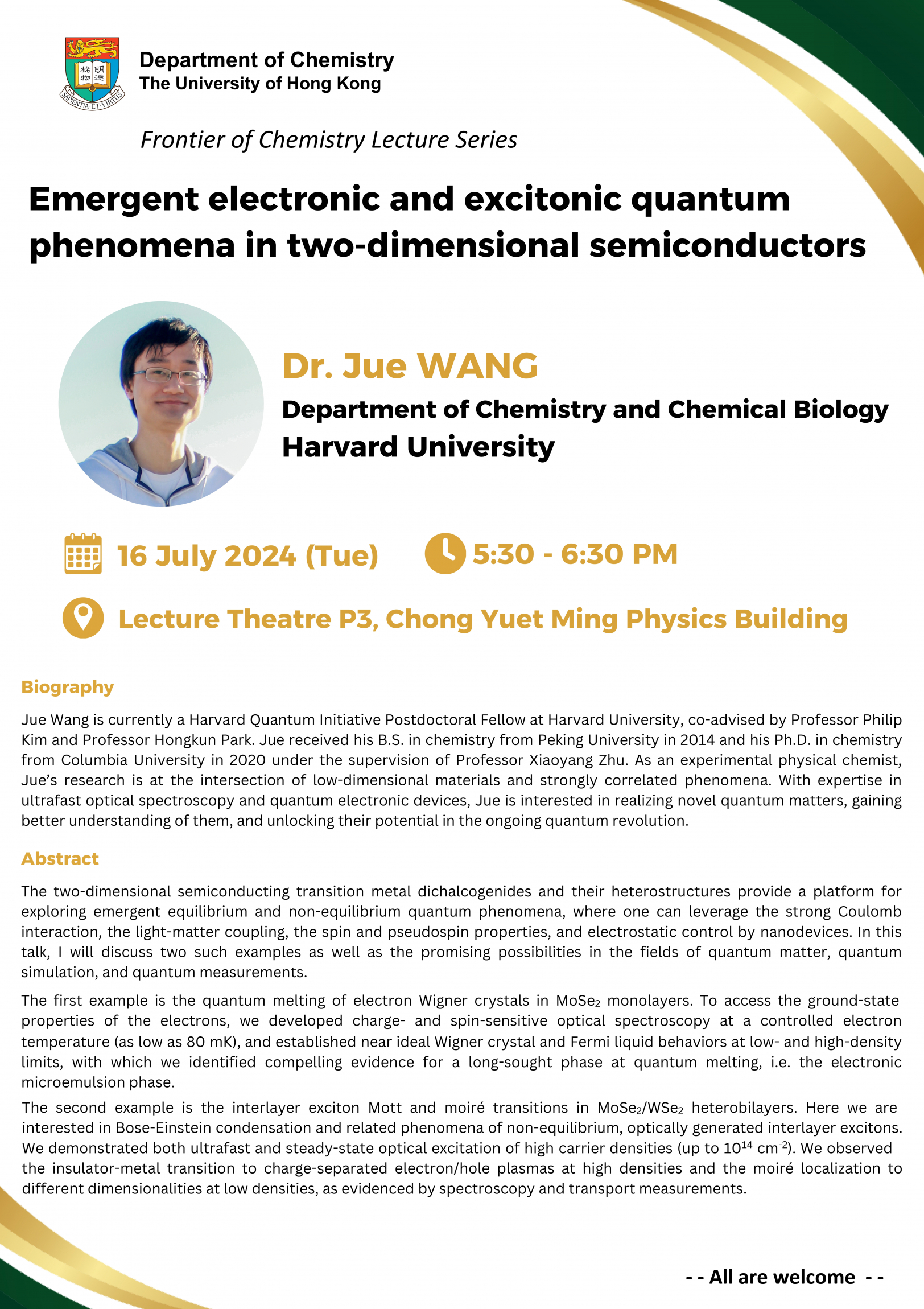| Date | 16 Jul 2024 |
| Time | 5:30 pm - 6:30 pm (HKT) |
| Venue | Lecture Theatre P3, Chong Yuet Ming Physics Building |
| Speaker | Dr. Jue WANG |
| Institution | Department of Chemistry and Chemical Biology, Harvard University |
 Title:
Title:Emergent electronic and excitonic quantum phenomena in two-dimensional semiconductors
Schedule:
Date: 16th July, 2024 (Tuesday)
Time: 5:30 - 6:30 pm (HKT)
Venue: Lecture Theatre P3, Chong Yuet Ming Physics Building
Speaker:
Dr. Jue WANG
Department of Chemistry and Chemical Biology
Harvard University
Biography:
Jue Wang is currently a Harvard Quantum Initiative Postdoctoral Fellow at Harvard University, co-advised by Professor Philip Kim and Professor Hongkun Park. Jue received his B.S. in chemistry from Peking University in 2014 and his Ph.D. in chemistry from Columbia University in 2020 under the supervision of Professor Xiaoyang Zhu. As an experimental physical chemist, Jue’s research is at the intersection of low-dimensional materials and strongly correlated phenomena. With expertise in ultrafast optical spectroscopy and quantum electronic devices, Jue is interested in realizing novel quantum matters, gaining better understanding of them, and unlocking their potential in the ongoing quantum revolution.
Abstract:
The two-dimensional semiconducting transition metal dichalcogenides and their heterostructures provide a platform for exploring emergent equilibrium and non-equilibrium quantum phenomena, where one can leverage the strong Coulomb interaction, the light-matter coupling, the spin and pseudospin properties, and electrostatic control by nanodevices. In this talk, I will discuss two such examples as well as the promising possibilities in the fields of quantum matter, quantum simulation, and quantum measurements.
The first example is the quantum melting of electron Wigner crystals in MoSe2 monolayers. To access the ground-state properties of the electrons, we developed charge- and spin-sensitive optical spectroscopy at a controlled electron temperature (as low as 80 mK), and established near ideal Wigner crystal and Fermi liquid behaviors at low- and high-density limits, with which we identified compelling evidence for a long-sought phase at quantum melting, i.e. the electronic microemulsion phase.
The second example is the interlayer exciton Mott and moiré transitions in MoSe2/WSe2 heterobilayers. Here we are interested in Bose-Einstein condensation and related phenomena of non-equilibrium, optically generated interlayer excitons. We demonstrated both ultrafast and steady-state optical excitation of high carrier densities (up to 1014 cm-2). We observed the insulator-metal transition to charge-separated electron/hole plasmas at high densities and the moiré localization to different dimensionalities at low densities, as evidenced by spectroscopy and transport measurements.
- - ALL ARE WELCOME --
